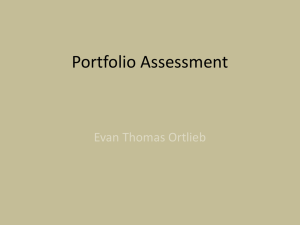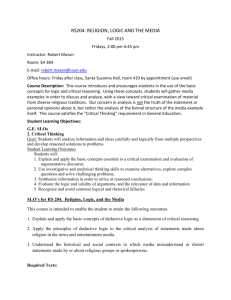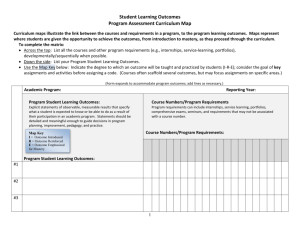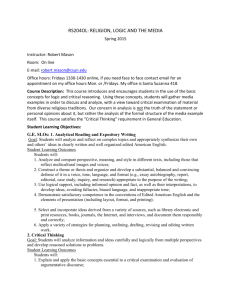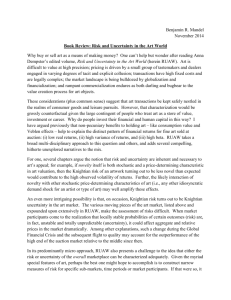19 Issues to Consider when Scoring Student Portfolios
advertisement
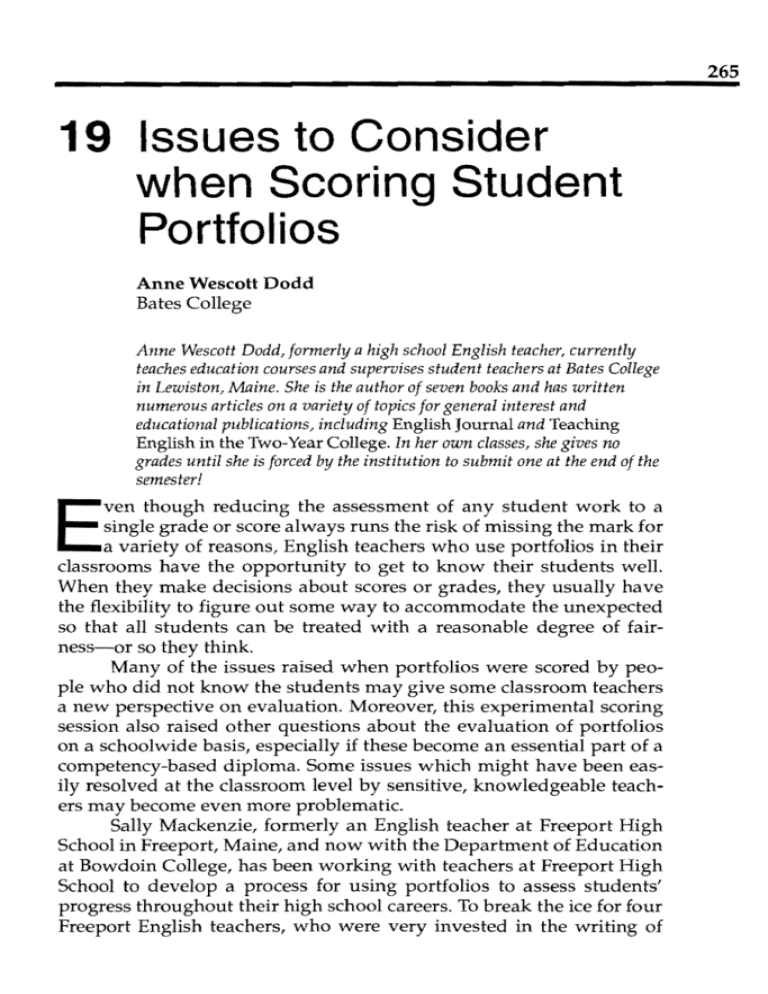
265 19 Issues to Consider when Scoring Student Portfolios Anne Wescott Dodd Bates College Anne Wescott Dodd, formerly a high school English teacher, currently teaches education courses and supervises student teachers at Bates College in Lewiston, Maine. She is the author of seven books and has written numerous articles on a variety of topics for general interest and educational publications, including English Journal and Teaching English in the Two-Year College. In her own classes, she gives no grades until she is forced by the institution to submit one at the end of the semester! E ven though reducing the assessment of any student work to a single grade or score always runs the risk of missing the mark for a variety of reasons, English teachers who use portfolios in their classrooms have the opportunity to get to know their students well. When they make decisions about scores or grades, they usually have the flexibility to figure out some way to accommodate the unexpected so that all students can be treated with a reasonable degree of fair­ ness-or so they think. Many of the issues raised when portfolios were scored by peo­ ple who did not know the students may give some classroom teachers a new perspective on evaluation. Moreover, this experimental scoring session also raised other questions about the evaluation of portfolios on a schoolwide basis, especially if these become an essential part of a competency-based diploma. Some issues which might have been eas­ ily resolved at the classroom level by sensitive, knowledgeable teach­ ers may become even more problematic. Sally Mackenzie, formerly an English teacher at Freeport High School in Freeport, Maine, and now with the Department of Education at Bowdoin College, has been working with teachers at Freeport High School to develop a process for using portfolios to assess students' progress throughout their high school careers. To break the ice for four Freeport English teachers, who were very invested in the writing of 266 Anne Wescott Dodd their own students, Sally organized a fishbowl discussion. This activ­ ity gave the teachers a chance to see how "outsiders" would respond to Freeport students' writing and how a rubric might be used for eval­ uation. I participated in this fishbowl activity along with two Bowdoin College students, two other members of the Bowdoin Education department, and the director of the Bowdoin Writing Project. As a result of our discussion, it became clear to me that there are several issues teachers need to consider in their own classrooms and in plan­ ning ways to extend portfolio evaluation beyond the classroom. The Context for Our Fishbowl Scoring Discussion Using a draft of a six-point holistic scoring guide (see Figure 1), the fishbowl participants scored and discussed six student portfolios selected by Sally as representative of the range of portfolios compiled by all of the seniors at Freeport High School. Although we looked only at senior portfolios, students at each grade level at Freeport High have been asked to compile portfolios. The requirements differ because the portfolios are tied to the curriculum at each grade level. The seniors had been given the following definition of a portfo­ lio by Freeport teachers: A portfolio is a collection of student work that exhibits to the student (and/or others) the student's efforts, progress, or achievement in (a) given area(s). This collection must include student participation in the selection of portfolio content, the criteria for selection, the criteria for judging merit, and evidence of student self-reflection. They were told that "outsiders" would be looking at their work and were given a copy of the draft scoring guide which had been developed by the teachers using the Maine Educational Assessment rubric as a base. Students were asked to include the following pieces of writing: • a business letter • a job or college application • a resume • an essay of self-reflection or self-regard (in many cases, stu­ dents chose the "college essay") • another piece of the student's choice Issues to Consider when Scoring Student Portfolios 6 Excellent in overall quality Substantial in content (length and development) Mature in style Demonstrates ability to handle prose tasks successfully Uses language creatively and effectively Strong voice. Clear sense of audience and context Often, there is a loose connection between the writer's sense of self and the writ­ ing. A "6" portfolio typically takes risks that work-either in content or form­ and challenges the reader by trying something new. 5 Very good in overall quality Substantial in content, although pieces are not as fully developed Uses language effectively, but not as creatively as a "6" Demonstrates ability to handle varied prose tasks successfully Voice is clear and distinct, if not powerful. Sense of audience is clearly present, if not always firm The "5" portfolio suggests the excellence that the "6" demonstrates. A "5" port­ folio tends not to take as many risks as a "6." 4 Good in overall quality Competent in content and style Inconsistent demonstration of ability to handle a variety of prose tasks suc­ cessfully and to use language effectively Sense of audience and task, but some of the writing seems formulaic or lacks a strong voice There are more strengths than weaknesses, but there may be an unevenness of quality or underdevelopment in one or two pieces. There seems to be minimal risk taking or originality. 3 Fair in overall quality One or more pieces may be too brief or underdeveloped Some evidence of ability to handle prose tasks successfully and to use lan­ guage effectively, but this is offset by recurring problems in either or both content and style Lacks both a clear sense of purpose and a distinctive voice The "3" suggests the competence that a "4" demonstrates. Strengths and weak­ nesses tend to be evenly balanced either within or among pieces. 2 Below average in overall quality The writing may be clear, focused, and error free, but it is usually thin in sub­ stance and undistinguished in style Two or more of the pieces may be either short and undeveloped or abstract and vague Little evidence of ability to handle varied prose tasks Weaknesses clearly predominate over strengths. The writer rarely takes risks, relying instead on formulas and cliches. 1 Poor in overall quality Characterized by brief pieces that are unoriginal and uncreative in style Major weaknesses and few, if any, strengths The seems to have been put together with very little time and thought. Figure 1. Freeport High School scoring guide. 267 Anne Wescott Dodd 268 As one might expect, students responded to the directions in very different ways. In some instances, these idiosyncrasies made it difficult for us to agree on a fair score for a student's portfolio. Before the fishbowl, we had been given the sample portfolios, so most of us had individually scored and noted comments on each one. As we shared our scores and the reasons for our decisions, we raised several issues regarding both the development of the portfolios and the scor­ ing; these issues stemmed from differences in the content of the indi­ vidual portfolios and the backgrounds of the students. Questions Raised from Considering the Sample Portfolios As teachers know, students do their best work when they feel some ownership of the task. Thus, an essential aspect of portfolio develop­ ment has been to allow students to choose some of the pieces they include. Freedom to choose, however, can lead to problems in scoring. The fishbowl group had to evaluate one portfolio that included a poem and others that contained writing from different genres. For example, while one student included an expository essay on The Can­ terbury Tales, another student chose a creative piece, "The New Canter­ bury Tales," written to imitate Chaucer's style. How does one evaluate such very different pieces? Some of us did not feel at all comfortable trying to assess the quality of writing of the poem, and we were not sure what to do with a portfolio that included only short pieces, most of which were personal and informal writing. Another difficulty in scoring stemmed from our lack of knowl­ edge about the context for inclusion of the pieces. For example, after some discussion about the lack of development in an essay about The Scarlet Letter, the teacher informed us that the class assignment from which the essay resulted had included a word limit. Perhaps knowing more about when and why the pieces were written would have made our scoring task easier. Should students be required to provide a brief introduction for each piece, telling when it was written, why, for what audience, and why they chose to include it? Two other problems also stemmed from the choices students made. First, it was impossible for us not to be influenced by the order of the pieces in the portfolios. What we saw first influenced our overall responses. When students chose to put the weaker writing first, for example, we sometimes found it difficult to give full weight to the higher quality of writing that came later. Second, because some stu­ Issues to Consider when ScoringS_t_u_d_e_n_tP_or_tfi,-o_1l~_·o_s____._ ____2_69 dents chose to include extra pieces, we had to struggle with finding a way to "count" these in the scoring without being unfair to the stu­ dents whose portfolios contained only what was required. Finally, because these students had to include resumes and application forms, we could not help but be aware of differences in their backgrounds. These differences created problems. Such differ­ ences are likely to be apparent even when there is less direct evidence than we saw in the resume and applications. Because some members of our fishbowl group were not experi­ enced teachers, this issue might have been exaggerated somewhat, but my own experience with high school teachers leads me to think that it will come up with any group of scorers. Some people, for example, value highly the kind of analytic writing that college-bound students are likely to include and tend to see pieces written by students who plan to attend a vocational school as superficial and undeveloped. In a more diverse community than Freeport, teachers may find that many students include writing which does not fit white mainstream middle­ class standards. How can the scoring-process design deal with these disparities? Should students be penalized for having different socio­ economic or cultural backgrounds? Recommendations On the basis of the preceding questions and other issues that arose during our discussion and scoring of this small number of sample essays, I offer the following suggestions for teachers who are planning to develop schoolwide evaluation of student portfolios. I believe that these recommendations are also important for individual teachers to consider as they grade portfolios in their own classrooms: 1. Decide up front the purpose of the evaluation, because those who score the portfolios will respond differently if their focus is to provide feedback rather than make a final judgment. If students compile portfolios each year they are in high school, for example, the first three may be consid­ ered as formative assessment, that is, a way of letting students know how they are doing so that they can work to improve their writing. In these portfolios, students might be asked to include pieces that focus on process. For example, students could include a "disaster" (an unsuccessful draft) and write a critique to show that they know how it might be improved. Or they might select one example to show the writing process as a whole: a series of notes and drafts of one piece, 270 Anne Wescott Dodd along with the final copy, as evidence of their ability to plan, write, revise, and edit. At the end of the senior year, especially if the portfolios become part of a competency-based diploma, however, the assessment logi­ cally would be a summative one, that is, a means of rendering a final decision about whether students' work meets minimum quality stan­ dards for graduation. At this point, it makes sense for students to include such items as college or job applications, but they might also be asked to choose some pieces written during the previous years. These pieces could show their progress over a longer period and allow them to demonstrate their ability in a wider range of genres. The Free­ port teachers, for example, noted that the curriculum prior to senior year included types of writing which would be considered more sub­ stantive than the job applications and resumes students do as seniors. 2. Think carefully about the core requirements and how these are described. The scoring will be easier and more equitable if students sub­ mit pieces in the same genres. Trying to evaluate apples (long research papers) and oranges (short personal essays written in class) at the same time can be problematic unless the scoring has been designed to accommodate a variety of student choices. 3. Ask the students to write introductions to their portfolios to tell readers what they think they do well and what they would like to do better. Some of the Freeport students did this even though it was not a requirement, and in each case these students correctly identified weak­ nesses we noticed in their writing. Perhaps the fact that students know what they need to improve on should count in the final score. 4. Ask students to write a brief introduction to each piece in the port­ folio so that readers can evaluate the degree to which the writing is successful for its intended purpose. As I mentioned earlier, one essay had been assigned with a word limit. That piece, which seemed thin and under­ developed on the first reading, actually seemed much better when we took into consideration the fact that for this assignment, the student had been asked to respond in no more than 200 words. Because audience and purpose are essential considerations when anyone writes, no writing can truly be considered effective with­ out taking into account the audience for whom it was intended and what it was supposed to accomplish. For example, the tone and con­ tent which would characterize effective writing in a personal response journal might be totally ineffective or inappropriate for an analytical essay or a business letter. Issues to Consider when 5. Consider encouraging students to look beyond work done for their English class when they collect pieces for their portfolios. Not only are the portfolios likely to be more interesting to readers, students will also get the message that good writing can be found everywhere. One of the Freeport teachers mentioned that a student had written a letter to the editor which had actually been published. Even though the letter was well written, the student had not chosen to include it in his portfo­ lio. If students are so engaged with writing that they are doing it on their own outside of school, shouldn't that evidence be considered in an evaluation of their progress or achievement? 6. Give students clear guidance regarding the development of their portfolios. Give them copies of the scoring guide, tell them who will do the scoring, and explain the process. Discuss such factors as the possi­ ble effect the order they choose for presenting their work may have on their scores, the importance of carefully following directions about the core requirements, and the wisdom of carefully proofreading the work they submit. Students should be reminded to make every effort to locate and correct typographical and other errors, i.e., to clean up their writing just as they would dress up for an interview for an office job, and to make sure everything they have included is complete. We read one essay with an ending missing due to a computer glitch and a job appli­ cation with the personal statement section left blank. 7. Thoughtfully develop the scoring guide to address specific issues that are likely to be problematic, but consider the guide as a draft which may need to be revised and reworked the next time. Some issues which the scor­ ing guide needs to take into account include the following: fa) How will extra pieces count in the total score? One possibil­ ity is to establish a score for the core pieces and then to award a bonus if the quality of the optional pieces warrants one. (Students would be told that extra pieces can help but will not hurt their scores.) Another option would be to incorporate a descriptor in the guide that deals with this. For example, the 6 score might say: "Shows evidence of a superior interest in writing by providing optional pieces of high qual­ ity." (b) How will you deal with pieces which do not fit the standards specified in the scoring guide or are expected by teachers? One way of handling the problem of differences that can occur in the level or types of writing done by college-bound and noncollege-bound students (or others) is to write some policy guidelines for scorers to follow. One 271 272 Anne Wescott Dodd possible statement: "When scoring, readers should forget their per­ sonal preferences for any particular type or characteristic of writing and evaluate a piece of writing solely in terms of whether or not it suc­ ceeds for the audience and task the writer has identified." Despite dif­ ferences in diction, tone, and length, then, the business letter written by a student applying for a gas station job, for example, could be con­ sidered just as effective as one written by a student applying for admission to an Ivy League college. (c) Should everything in the portfolio be considered in the final score? The fishbowl group found the job applications problematic because not all of them included writing. Filling in the blanks seemed to be a reflection of a student's ability to follow directions. Perhaps such items might not be scored at all, even though they are very appropriate to include in an exit portfolio at the end of high school. Since I participated in this experiment, I have discovered an­ other strategy for increasing student understanding of the evaluation criteria and also, perhaps, their scores. Instead of giving a final exam in my college classes ("Special Education" and "Gender Issues and Education"), I require students to compile portfolios which demon­ strate their learning during the semester. One very important compo­ nent is a list of "big ideas" or major concepts which students explain by integrating specific examples from the course reading, class discus­ sions, field-experience placements in public schools, and their own prior experience and knowledge. To help students internalize the eval­ uative criteria, I ask them at midterm to write up one of these "big ideas" in essay form (as it would be done for the final portfolio). Each student is then given a scoring sheet and asked to evaluate a class­ mate's sample essay and provide feedback. I also score these sample essays afterward. This practice enables students to understand both the way a holistic scoring process works and a rating of their work in relation to the evaluation criteria, which is nonjudgmental at this point. There is no doubt that portfolios are much better than on­ demand, timed essays for evaluating students' achievement in writing and in other curricular areas as well. Portfolios give a much broader picture of what students know or can do. Teachers or others can see how students handle many different types of writing as well as varied aspects of the writing process or other topics of study. But if students have some choices about their development, portfolios are perhaps most important because they can motivate stu­ Issues to Consider when Scoring Stude_n_tP_or-,tfi,-o_li_os~__.._ __._ __._ _2_7_3 dents to take a greater interest in improving their writing skills. By col­ lecting their work in classroom portfolios, students can see their progress over time. As their folders get fatter and fatter, they can also feel a sense of accomplishment. If students also have to compile portfolios for schoolwide scor­ ing, they will experience the pleasure, or maybe the pain, of going public with one's writing. Either way, they will get valuable experi­ ence for adjusting to real-world demands they will face when they graduate from high school. Because portfolios are personal, they can be very powerful for students, but as our fishbowl conversation made clear to me, they can also be very problematic for the teachers who have to score them. By being aware of potential problems and attempt­ ing to deal with them beforehand, teachers can help to make the scor­ ing process smoother and more equitable. Because it is doubtful that anyone will ever be able to design the perfect scoring process, any pro­ cess or rubric should be thought of as a draft, subject to future revision as knowledge increases with experience. Thus, portfolio evaluation in the classroom or in a school is likely to work best when reflective teachers make decisions thoughtfully and sensitively.


